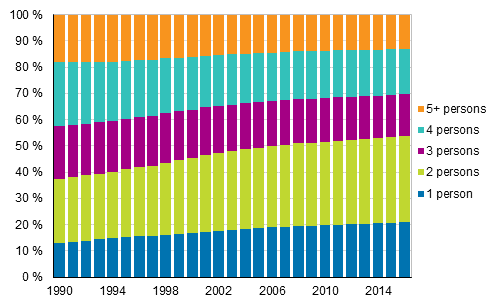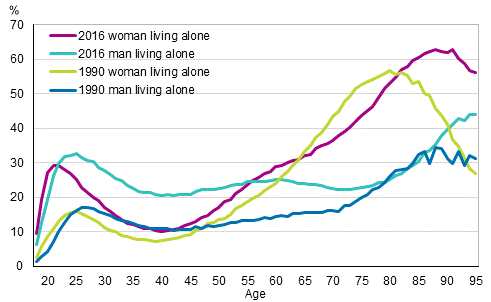7. Living alone is more typical for women
The proportion of those living alone of the total population has gradually grown from 16 per cent two decades ago to today's 21 per cent. Around one-third of the population live in two-person household-dwelling units. Thirteen per cent live in household-dwelling units with at least five persons.
Figure 13. Household-dwelling unit population by size in 1990–2016

In all, women live by themselves more often than men do. In percentages, 27 per cent of the women and 24 per cent of the men aged over 18 years live alone. Living alone is divided by age slightly differently for men and women. In the lifecycle of women, living alone varies more than among men. More than every fourth women aged slightly over 20 live alone, after which the probability of living alone falls. Living alone is most probable at old age: over one-half of women aged over 80 live alone. Women living alone is rarest in the age group 39 to 41, when every tenth woman lives alone.
Similarly as for young women, over one-quarter of young men live alone. However, the number of men living alone does not decrease in young adulthood as much as living alone for women. The proportion of men living alone is at its lowest in the age group 39 to 45, when slightly over one-fifth of men are living alone. The proportion of men living alone remains at good one fifth until the age of nearly 80. After this, the proportion of men living alone grows. Even in the oldest age group of all close on one-half of men live alone.
After 1990, men living alone has become more common in all age groups, particularly among men at working age and those aged over 90. For women, living alone has become more common especially for those aged under 25 and over 85. It is now rarer for women aged 65 to 80 to live alone than in 1990. In absolute numbers, the biggest groups of those living alone by gender are women aged 69, in all 14,200 persons, and men aged 25, i.e. 11,700 persons.
Figure 14. Men and women living alone as a proportion of age group in 1990 and 2016

Source: Population and Justice Statistics, Statistics Finland
Inquiries: Marjut Pietilšinen 029 551 2798, Timo Nikander 029 551 3250, Joonas Toivola 029 551 3355, info@stat.fi
Director in charge: Jari Tarkoma
Updated 24.11.2017
Official Statistics of Finland (OSF):
Families [e-publication].
ISSN=1798-3231. Annual Review 2016,
7. Living alone is more typical for women
. Helsinki: Statistics Finland [referred: 23.12.2025].
Access method: http://stat.fi/til/perh/2016/02/perh_2016_02_2017-11-24_kat_007_en.html

